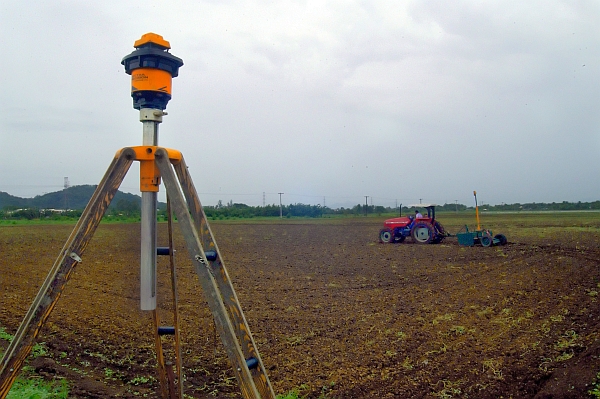By Jeff Smith
A newly published study of rice-wheat agriculture in Pakistan shows that, while many farmers adopt water conservation technologies such as zero tillage, water use has actually risen, contributing to groundwater depletion.

There were two reasons for this. First, when less water was needed because of the new technologies, the ‘saved’ water was used to intensify production or expand farming areas. Second, much of the water that was previously ‘wasted’ had actually gone into the groundwater table, from which it was pumped again. Thus, there was less ‘waste’ than might have been thought.
“Water savings aren’t as clear as one might think,” says Mark Giordano, Associate Professor of Environment and Energy, School of Foreign Service, Georgetown University, USA (formerly Theme Leader for the International Water Management Institute’s (IWMI’s) research theme on Water and Society).
According to Giordano, this is also the case for other technologies which are often assumed to ‘save’ water, such as drip irrigation or lining earthen irrigation canals with concrete.
Giordano co-authored the paper, Constraints and opportunities for water savings and increasing productivity through Resource Conservation Technologies in Pakistan, which will be published by the journal, Agriculture, Ecosystems & Environment.
This paper, prepared by Mark Giordano during his time at IWMI as Theme Leader – Water and Society, also included two further co-authors, Mobin-ud-Din Ahmad and Ilyas Masih, who were former IWMI colleagues. Mobin-ud-Din Ahmad is research team leader/irrigation hydrology at the Commonwealth Scientific and Industrial Research Organisation (CSIRO), Australia’s national science agency; and Ilyas Masih is a lecturer in water resources planning at UNESCO-IHE Institute for Water Education, Delft, the Netherlands.
The authors note that this phenomenon is similar to what has been documented in the energy-efficiency field, i.e., new technologies may induce people to use more of a resource.
Pakistan is a good test bed for water-saving technologies. It is the sixth most populous country in the world with 185 million people and is growing fast with the population expected to reach more than 230 million by 2030. This growth in population poses serious food security concerns. More than a quarter of the population (28%) are considered to be severely food-insecure with an intake of less than 1,700 calories a day per person (www.foodsecurityportal.org/pakistan)
A key constraint is the lack of additional freshwater resources for agricultural use, which means that food production must become more water-efficient. Resource Conservation Technologies (RCTs) have been promoted as a solution for growing rice and wheat, in particular, which make up a combined 90% of the country’s total grain production.
The study focused on semi-arid Punjab, the country’s breadbasket, where rice is grown during the monsoon season and wheat during the dry season.
Zero tillage and laser land leveling are the RCTs most widely adopted by Pakistani farmers. Zero or no-till farming is the method of growing crops without disturbing the soil. The technique has been found to increase the amount of water and organic matter (residue from the previous year’s crops) available, and decrease soil erosion and energy use.
The area under laser land leveling in Pakistan is estimated at 0.7 million hectares (Mha), while zero tillage wheat farming was recently estimated at 0.3 Mha. The impacts on agricultural yields are straightforward to measure, but water has complex movements.
The researchers cited physical measurements and farmer survey data to explain the main drivers of adoption of RCTs. Main incentives for adoption include coping with water scarcity and increased profitability due to reduced production costs and higher yields. Additionally, under zero tillage, wheat benefits from residual soil moisture when planted after rice.
A review by the authors of other studies shows that wheat grown under zero tillage and laser land leveling has contributed to significant water savings and higher yields in parts of Pakistan, India and China.
However, the paper demonstrated that water savings at the field level couldn’t be extrapolated to larger scales. The authors stated that ‘real’ water savings depend on many factors, including what farmers do with the water saved, and the hydrologic interactions between farms and the entire river basin.
In fact, water savings often stimulate greater total water use – unless policies are in place to limit demand. According to the researchers, an example of this is the areas where the excess irrigation water percolates into the aquifer and is then pumped out again by the same or other farmers.
In Pakistan, farm size has become the de facto governing factor. In areas where smallholder farmers are the majority, water may not easily be reused and there might be cumulative savings at the system level. Alternatively, the savings might result in a more generous water supply for downstream users. Farmers with medium to large plots are more likely to use water savings to intensify or increase their cropping areas.
While the study found an increase in the use of RCTs, a considerable 30% of those growing wheat under zero tillage reported losses in yields, which highlights the need for further improvements in farmers’ use of the technology.
[hr top=”yes”/]
Article:
Constraints and opportunities for water savings and increasing productivity through Resource Conservation Technologies in Pakistan
Ahmad, M.D.; Masih, I.; Giordano, M. 2013. Constraints and opportunities for water savings and increasing productivity through Resource Conservation Technologies in Pakistan. Agriculture, Ecosystems and Environment. 10p.

